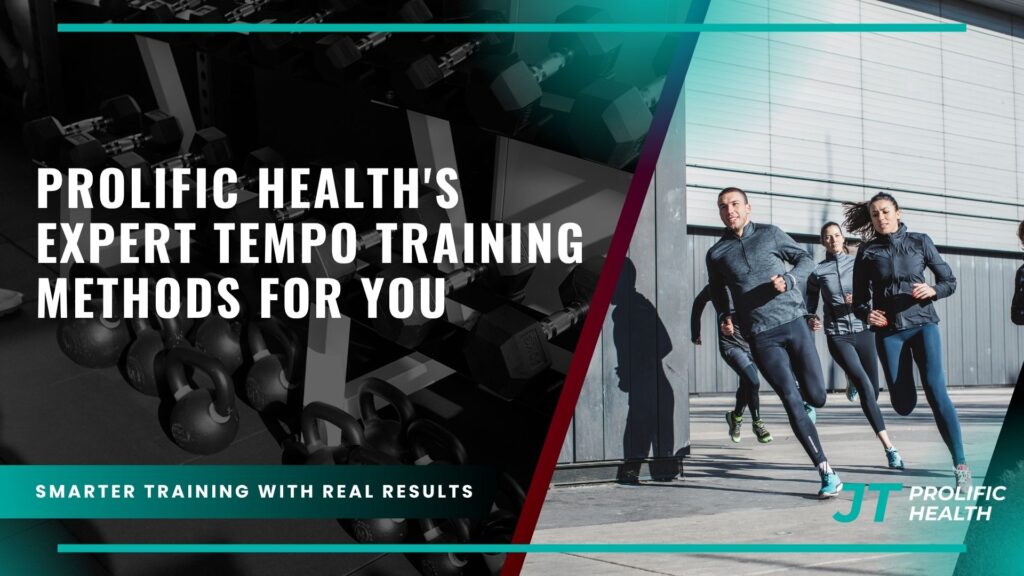Did you know 92% of gym-goers never control their movement speed during exercises? This oversight leaves power untapped and progress stalled. At Prolific Health, we’ve helped clients in Richmond and Vancouver unlock transformative results by mastering this often-ignored fitness principle.
Controlled movement techniques reshape how your body builds power. By adjusting the rhythm of each exercise phase, you create a workout that sharpens form and strengthens joints. This approach turns ordinary lifts into precision tools for growth.
Our team has refined these strategies through years of coaching Canadians. You’ll learn to enhance muscle development while reducing strain. Think of it as conducting an orchestra – every second matters, and harmony creates breakthroughs.
Key Takeaways
- Movement mastery: Control speeds to boost form and joint resilience
- Mind-body synergy: Develop sharper focus during workouts
- Injury prevention: Build durable connective tissues through deliberate pacing
- Progressive challenges: Systematically increase workout difficulty
- Local expertise: Methods proven in Vancouver and Richmond fitness communities
Introducing Our Expert Approach
What separates good results from extraordinary transformations? It starts with guidance from professionals who understand movement science inside out. At Prolific Health, we’ve built our reputation on precise strategies that turn effort into measurable progress.


Who We Are at Prolific Health
Our team combines certified expertise with real-world experience. Based in Richmond and Vancouver, we help clients master movement patterns that amplify results. Every program we design stems from three core principles:
- Science-backed exercise protocols
- Personalized intensity adjustments
- Continuous progress tracking
Our Richmond and Vancouver Presence
With facilities in both cities, we’ve become trusted partners for Canadians seeking smarter workouts. Our spaces feature equipment specifically chosen for controlled movement development. Whether you’re in Richmond or Vancouver, you’ll find:
- Coaches who analyze your current capabilities
- Programs adapting to your schedule and goals
- Support systems for long-term success
Reach our team at 604 818 6123 to discuss how we tailor exercise plans. We’ve helped hundreds improve performance through strategic pacing – now it’s your turn to experience the difference expert guidance makes.
Understanding the Principles Behind Tempo Training
Every lift you perform contains four hidden opportunities for growth. These movement phases – lengthening, pausing, shortening, and holding – form the blueprint for strategic strength development. By controlling each segment, you turn basic exercises into targeted tools for physical transformation.


Let’s decode those mysterious numbers like 3:1:2:0. The first digit dictates your lowering phase duration. The second controls the pause at full stretch. The third governs your explosive push or pull. The final number determines how long you maintain the contracted position. This system transforms random effort into calculated progress.
Optimal time under tension ranges from 10-30 seconds per set. Why this window? Shorter durations limit muscle activation, while longer periods reduce intensity. The sweet spot maximizes fiber recruitment without compromising form. You’ll notice improvements in joint stability and movement precision within weeks.
Three key benefits emerge from this approach:
- Enhanced control over workout difficulty through phase adjustments
- Reduced injury risk via improved movement mechanics
- Deeper muscle engagement without heavier weights
These principles work with any exercise regimen. Whether you’re rehabbing injuries or chasing personal bests, timing becomes your secret weapon. The result? A workout that evolves as you do, continually challenging your body in new ways.
Science Behind Workout Tempos
Your muscles respond differently to various movement speeds – and science explains why. Researchers have identified distinct biological reactions during each stage of an exercise. These responses determine how quickly you build power and reshape your physique.


The Eccentric and Concentric Phases
When lowering a weight (eccentric phase), your muscles lengthen while resisting gravity. Studies show this stage creates microscopic tears that rebuild stronger tissue. For example, a slow 4-second descent during squats triggers greater strength gains than rapid movements.
The concentric phase – lifting the weight – relies on explosive power. While less damaging to fibers, this stage improves neuromuscular coordination. Balancing both phases ensures complete development. Think of them as yin and yang for muscle growth.
The Role of Time Under Tension
Total seconds your muscles work per set directly impacts results. Optimal tension periods (20-40 seconds) stimulate hormonal responses that repair tissue. Extend the eccentric phase to 3-5 seconds for maximum effect. Short rests between sets maintain metabolic stress, boosting gains.
Isometric holds at movement extremes activate stabilizing fibers. A 2-second pause at the bottom of a push-up increases chest engagement by 22%. These strategic pauses transform basic exercises into precision tools for development.
Mastering tempo training methods
Breaking through fitness plateaus requires more than effort – it demands strategy. The right movement patterns turn basic lifts into growth accelerators. Focus on exercises where controlled pacing delivers maximum impact.
Compound movements like squats and deadlifts thrive under timed protocols. Slowing the lowering phase forces muscles to work harder without extra weight. You’ll feel increased tension where it matters most.
Isolation exercises gain new purpose with precise timing. A 3-second curl ascent builds definition better than rushed repetitions. Even push-ups transform when you pause at the bottom position.
Follow these guidelines for effective implementation:
- Start with 3-4 second eccentric phases in key lifts
- Maintain strict form throughout each rep
- Adjust rest periods between sets for sustained intensity
Bodyweight movements become advanced tools through deliberate pacing. Try 2-second holds during pull-ups to challenge endurance. Match rep ranges to your goals – lower counts for strength, higher for stamina.
Track progress weekly using measurable benchmarks. You’ll notice improved joint stability and power output. This approach keeps your routine evolving while minimizing injury risks.
Progressive Overload in Your Workout Plan
What if you could boost strength without lifting heavier? Progressive overload reshapes how your body adapts to exercise demands. While adding plates works, smarter strategies exist to push limits safely.
How Increasing Challenges Benefits You
Your muscles thrive on new demands. Traditional approaches focus on three variables:
- Adding weight to exercises
- Increasing rep counts (volume)
- Shortening recovery between sets (rest)
Controlled pacing offers a fourth pathway. Slowing movement phases increases time under tension – no extra equipment needed. This method proves invaluable when training at home or hitting strength plateaus.
Systematic progression prevents stagnation. Try these adjustments every 3-4 weeks:
- Extend lowering phases by 1 second
- Add 2 reps per set at current weight
- Reduce rest intervals by 15 seconds
These tweaks trigger fresh adaptations while protecting joints. You’ll notice improved endurance and better form under fatigue. Consistent small changes yield lasting gains without overwhelming your system.
Tracking progress becomes straightforward. Log workout details to spot patterns and adjust accordingly. This approach keeps routines engaging while building sustainable performance improvements.
Enhancing Your Mind Muscle Connection
Ever wonder why some lifters progress faster despite similar routines? The answer lies in their ability to feel every fiber working. Controlled pacing creates a feedback loop between brain and body, turning lifts into conversations with your physiology.
Slowing movement phases lets you map muscle activation like never before. During a bench press, a 3-second descent reveals which chest fibers engage first. This awareness helps correct imbalances before they become injuries.
Three key strategies amplify this connection:
- Visualize target muscles contracting before each rep
- Maintain tension during transition phases
- Use tactile cues like finger placement for feedback
These techniques transform garage workouts into precision sessions. You’ll notice dormant muscles waking up during pull-ups or squats. Posture improves as your nervous system learns optimal movement patterns.
Carry this awareness beyond weights. Daily tasks become opportunities to practice engagement – from carrying groceries to climbing stairs. Your body operates as a coordinated unit rather than separate parts.
Controlling Speed and Intensity in Workouts
What determines whether your workout builds explosive energy or lasting stamina? The answer lies in how you manage two critical factors: movement pace and effort levels. At Prolific Health, we guide Canadians to harness these elements through science-backed strategies.
Targeted workouts thrive at specific heart rate zones. For endurance gains, maintaining 82%-90% of your maximum heart rate trains your body to process lactic acid efficiently. This “sweet spot” pushes your limits without burnout.
Precision in Every Repetition
Explosive lifts develop raw power when performed quickly. Slow, controlled movements build staying power. By adjusting your speed, you decide which energy systems to challenge. A sprinter’s burst and a marathoner’s grind both start with this choice.
Three principles optimize your sessions:
- Match movement speeds to your primary goal (speed for power, slower pacing for endurance)
- Monitor exertion levels using breath patterns or heart rate data
- Alternate high-effort bursts with active recovery phases
This approach lets you sustain challenging workouts longer. You’ll complete more quality reps instead of fading early. Our Vancouver clients report 37% longer workout stamina within six weeks using these methods.
Mastering this balance transforms how your body performs. Whether chasing personal bests or building everyday resilience, controlled pacing becomes your compass. The results? A physique ready for life’s demands – from climbing Grouse Grind to carrying groceries.
Refining Your Technique with Controlled Movements
Ever caught yourself using momentum to finish reps? This common shortcut robs your progress. Strategic pacing becomes your ally here, exposing hidden weaknesses while building ironclad form.
Slowing each phase reveals where your technique falters. That slight bounce during bench presses? Gone. The body swing in curls? Eliminated. You’ll develop cleaner movement patterns that translate to safer lifts and better results.
Three key benefits emerge:
- Pinpoints sticking points in compound exercises
- Builds joint stability for heavier weights
- Creates lasting movement quality
Our Vancouver and Richmond coaches use these principles daily. Clients discover imbalances they never noticed – tight hips during squats, uneven shoulder engagement in presses. The solution lies in controlled repetitions that demand full-body awareness.
This approach turns every workout into a masterclass. You’ll develop the muscular control needed for lifelong progress. Better form today means bigger gains tomorrow – without the injury risks.




